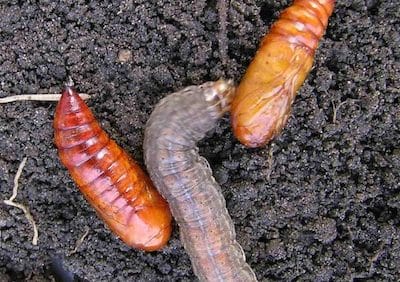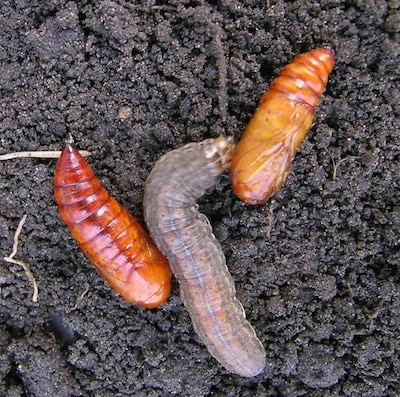
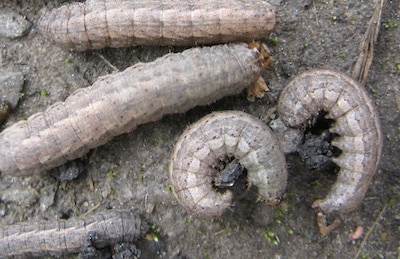
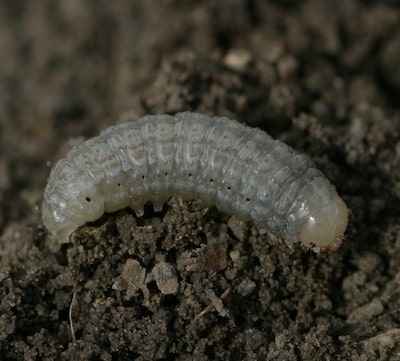
Cutworms can leave canola fields with bare patches, clipped plants and large chunks out of stems and leaves. Flocks of birds — crows, gulls, etc. — can be a sign that cutworms are present in large numbers, but nothing beats digging to confirm your suspicions.
Cutworm thresholds are based on stand reduction, not actual cutworm counts. The threshold for canola is 25% to 30% stand reduction. With a stand reduction of less than 25%, canola plants may be able to branch out and compensate for some of the damaged or killed plants. However, if bare patches are developing as a result of cutworm feeding, these should be managed to limit their size, as the complete lack of plants does not allow for any compensation to occur. Spot spraying the patches and the surrounding crop where cutworms are present may be sufficient.
Here’s how to scout:
Start with an above-ground scout of the canola stand. Look for bare patches, holes or notches in foliage, and clipped plants.
Start digging where you find damaged or missing plants. Digging is required not to count the cutworms, but to confirm that cutworms are in fact present and feeding. Cutworms feed above ground at night and go below ground during the day. In moist soils, cutworms will stay close to the surface. In dry soils, they may go down 8-10 cm (up to 4”). Dig up soil from a one square foot area to a depth of 10 cm and put it into a basin. Loosen the soil and shake it up to activate cutworms. Also look for frass (cutworm excrement) around roots. Repeat a few times throughout the field.
Try to identify the cutworm species. Knowing the species can be helpful in fine-tuning the control measures.
Look for orange pupae. Cutworms are not feeding at this stage and are no longer a threat to this year’s crop. If most cutworms are greater than 1 inch, they will quit feeding and pupate soon, so an insecticide is less likely to provide an economical yield increase.
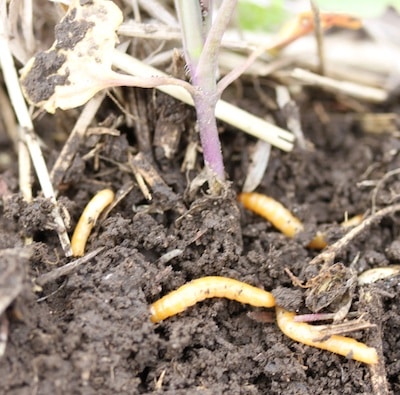
Look for wireworms. Wireworms are another below-ground feeder and can cause similar bald patches to appear in canola fields. All cutworms will curl into a ball. Wireworms do not. Wireworms are straw-colored and do not have a prominent head. No products are registered (or effective) for wireworm control in canola. If wireworms are the culprit, put away the sprayer and make note of areas or fields where the damage was higher. Remember these areas when planning crops and seed treatments for next year.
Cutworm control
Cutworms surface at night to do their above ground feeding, so spray as close to nightfall as possible. Since not all cutworms will surface on a single night, it may take several days before full effect of the insecticide is achieved.
Cutworms do not feed during molting stages — when they shed and grow a new larger skin. This can take up to a week, and 20% to 50% of cutworms can be molting at any given time. Registered insecticides generally have long enough residues to be active when molting cutworms start feeding again.
Use high water volumes to get good plant coverage. Cutworms need to ingest the insecticide so the more surface area covered, the more likely that cutworms will take in the insecticide.
Cutworm damage will often appear in patches. If stand reduction is concentrated in small areas, a targeted application of a sprayer width or two around that area can be a lower cost and effective way to manage the pest compared to spraying a whole field.
Listen to CCC agronomy specialist Troy Prosofsky provide an insect update.
